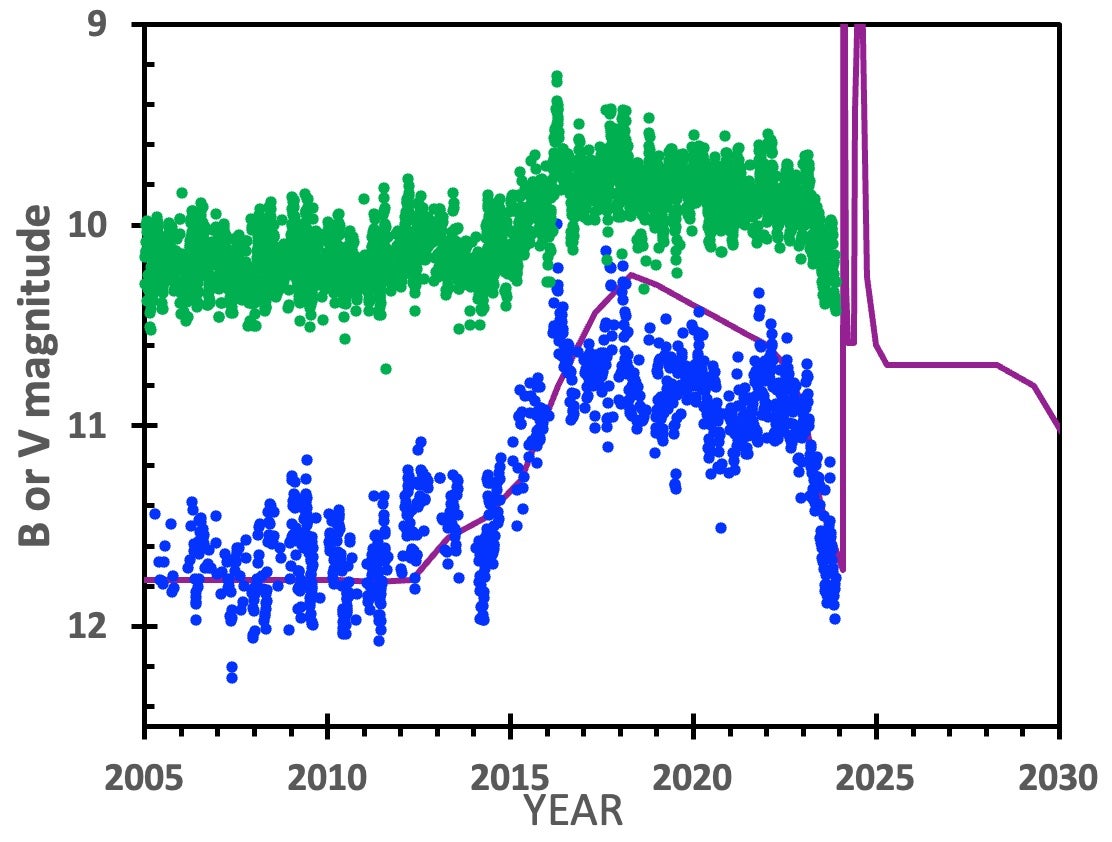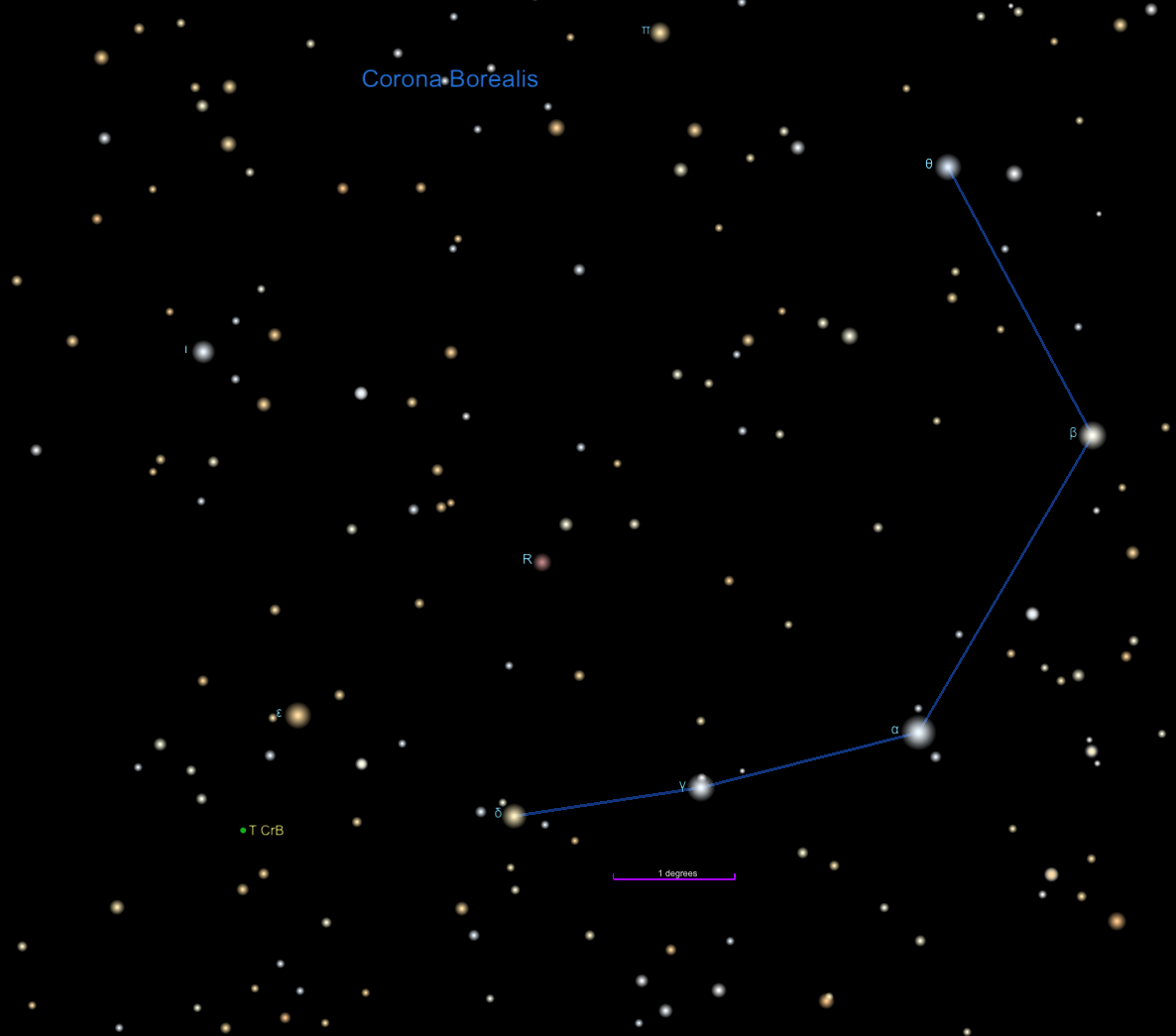
A star that hasn’t been seen with the naked eye since the 1940s will appear for a fleeting moment in our night sky this year. The luminous point of light is the effect of an outburst, called a nova, from a star system known as T Coronae Borealis (T CrB). T CrB has charmed many generations of astronomers who have tracked, read historical records, or seen the star. Its previous eruptions have been observed since at least 1217 A.D.
Outbursts from T CrB happen every eight decades or so. The last outburst was documented in 1946. The next one is expected between now and September. “This is the one big chance you have of seeing the brightest nova of the generation,” says Bradley Schaefer, professor emeritus at Louisiana State University and longtime observer of T CrB.
T CrB’s 80-year cycle is well documented. It follows the same phases. The star is stable and then begins to ramp up in brightness before undergoing a pre-eruption dip in magnitude and, about 11 months later, a big explosion. In 2015, scientists noticed it was starting to fluctuate; then, last April, T CrB observers noticed its brightness dip. “T CrB could go up any night now. Or it might go up any month now,” Schaefer says. It’s hard to predict, he admits, “but probably sometime this year.”
RELATED: Is T Coronae Borealis rising? | See the latest data from the AAVSO
Bursts of light
T CrB is a recurrent nova that briefly increases in brightness about once a century. These types of novae are extremely rare, with less than a dozen known in the Milky Way. However, there could be more with longer baselines, perhaps taking thousands to hundreds of thousands of years to reach an outburst. Scientists are still trying to figure out what about T CrB allows it to create these big explosions every 80 years or so. But some suspect it might have to do with the white dwarf’s large mass, which is close to the upper limit for such an object.
T CrB (and all novae) consists of a red giant and a white dwarf orbiting each other. Over the last 80 years, the white dwarf has insatiably collected matter from its companion as it blows away its outer atmosphere. It accumulates one Earth mass roughly every 50 years, says Schaefer.
As material piles on, the pressure and temperature of material on the white dwarf’s surface increase. Eventually, it will reach hydrogen’s ignition temperature and burst, going off like a Hydrogen bomb. “That’s what they were talking about at the end of Oppenheimer. That’s what they’re trying to make. But the stars have been doing it for a long time,” Schaefer says.
The blast, though, doesn’t destroy the white dwarf. Instead, it simply wipes away the accreted material, allowing the white dwarf to begin accumulating more as the process repeats.
According to Schaefer, the earliest observation of T CrB was in 1217. That year, German Monks near Augsburg saw a faint star briefly brighten in the sky. After its well-documented 1866 eruption, astronomers were able to calculate its next eruption would be in 1946, shortly before which amateur astronomer Leslie C. Peltier noticed a telltale dip in the star’s brightness. (Famously, Peltier missed the outburst itself, staying in bed that night because of a cold.)
Amateur astronomers have provided a significant portion of the observations on T CrB since its 1866 eruption. Schaefer has published various papers on T CrB and even assembled a light curve (which measures brightness over time) from the observations of amateur astronomers. And based on the star’s current activity, scientists predict it will go off very soon.

How to observe T CrB’s explosive show
Typically, T CrB is not visible to the naked eye at a magnitude of 10. When it reaches peak brightness, T CrB will be comparable to Polaris, the North Star, which has a magnitude of 2. (The smaller the number, the brighter it is.) It should remain this bright for a few days to a week before vanishing again.

To find the star, observers should look for Corona Borealis the Northern Crown, a curved constellation just west of Hercules, best seen in the Northern Hemisphere. The crown’s brightest star is Alpha (α) CrB, at magnitude 2.2 — about as bright as T CrB will appear in outburst. From there, look east down the crown’s curve, passing the stars Gamma (γ) and Delta (δ) CrB. The soon-to-be showstopper, T CrB, is about 2.2° east of Delta. While not visible to the naked eye, T CrB can currently be seen with a telescope or binoculars.

When T CrB goes off, it will only be at maximum brightness for half a day before you must wait another 80 years to see it with your naked eyes. So go out and keep an eye on it!
Correction: An earlier version of this article had an artist’s impression of the outburst that was not completely accurate. It has been removed.









